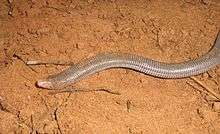Amphisbaena mertensii
Amphisbaena mertensii, also known as the Mertens' worm lizard or Mertens's worm lizard, is a species of worm lizard in the family Amphisbaenidae. The species is endemic to South America.
| Amphisbaena mertensii | |
|---|---|
 | |
| Scientific classification | |
| Kingdom: | Animalia |
| Phylum: | Chordata |
| Class: | Reptilia |
| Order: | Squamata |
| Family: | Amphisbaenidae |
| Genus: | Amphisbaena |
| Species: | A. mertensii |
| Binomial name | |
| Amphisbaena mertensii Strauch, 1881 | |
| Synonyms[2] | |
Defensive behavior
Amphisbaenians are fossorial reptiles with few predators due to their powerful bite and writhing defensive tactics.[3] However, some snakes have been found feeding on amphisbaenians including A. mertensii.[3] This species is also able to defend itself against dangerous predators such as snakes by releasing a foul discharge from its cloacal region.[3]
Etymology
The specific name, mertensii, is in honor of a Dr. Mertens who collected the holotype.[4][5]
Geographic range
A. mertensii is found in northern Argentina, southeastern Brazil, and eastern Paraguay.[2]
Reproduction
gollark: Not all of them have an integration role.
gollark: 500 bots, actually.
gollark: It's mostly bot roles. Which I can't remove without the hassle of removing and readding each bot, unless there's a better way, which I was asking about (Discord is known for weird poorly documented features).
gollark: > You can have up to 250 roles in a serverYes, I reached that. But removing and readding bots to make role space is inconvenient.
gollark: Can I remove this "integration" role without just removing the bot entirely? I have a few hundred of these due to reasons and it appears to have reached the role limit.
References
- Montero, R. (2019). "Amphisbaena mertensii". IUCN Red List of Threatened Species. 2019: e.T56039194A56039199. doi:10.2305/IUCN.UK.2019-2.RLTS.T56039194A56039199.en.
- Species Amphisbaena mertensii at The Reptile Database . www.reptile-database.org.
- Barbo, Fausto Errito & Marques, Otavio A. V. (2003). "Do aglyphous colubrid snakes prey on live amphisbaenids able to bite?". Phyllomedusa. 2 (2): 113–114. doi:10.11606/issn.2316-9079.v2i2p113-114.
- Strauch A (1881). "Bemerkungen über die Eidechsenfamilie der Amphisbaeniden ". Mélange biologiques tirés du Bulletin physico-mathématique de l'Académie des Sciences de Saint-Pétersburg 11: 355-479. (Amphisbaena mertensii, new species, p. 385). (Reprinted from Bulletin de l'Académie Impériale des Sciences de Saint-Pétersbourg 28: 45-131). (in German).
- Gans, Carl (1966). "Redescription of Amphisbaena mertensi Strauch, with comments on its geographic variation and synonymy (Amphisbaenia: Reptilia)". Copeia. 1966 (3): 534–548. doi:10.2307/1441079. JSTOR 1441079.
Further reading
- Boulenger GA (1885). Catalogue of the Lizards in the British Museum (Natural History). Second Edition. Volume II. ... Amphisbænidæ. London: Trustees of the British Museum (Natural History). (Taylor and Francis, printers). xiii + 497 pp. + Plates I-XXIV. (Amphisbæna mertensii, p. 441).
- Gans C (2005). "Checklist and Bibliography of the Amphisbaenia of the World". Bulletin of the American Museum of Natural History (289): 1–130. (Amphisbaena mertensii, p. 17.)
This article is issued from Wikipedia. The text is licensed under Creative Commons - Attribution - Sharealike. Additional terms may apply for the media files.
